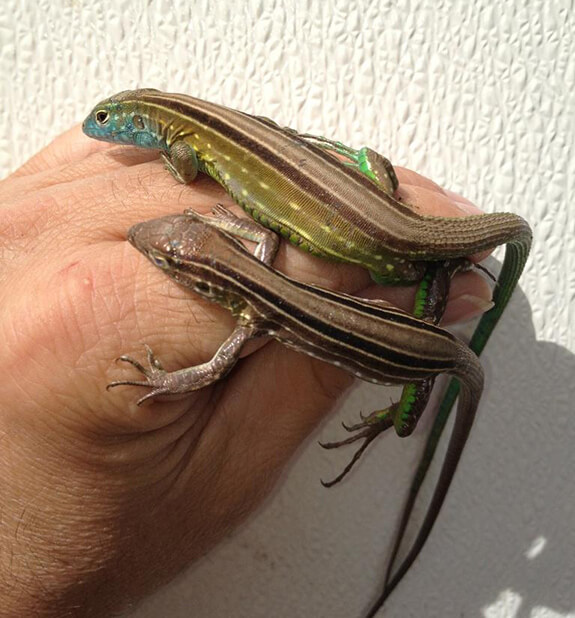A Quick Peek At Whiptails (Teiidae)
The stomach scales of the Teiidae are much larger than those of other lizards.
Differences between sexes: In the sexually mature male the head is somewhat broader and foreshortened and the femoral pores are much more noticeably prominent than in the female. The base of the tail of the male is thickened by the presence of the hemipenis sheath. A definite determination of sex, particularly for juveniles, is only possible with the use of a probe.

Reproduction: In nature tegus lay their eggs in termite hills, which not only protects them from predators but also provides them with a constantly maintained temperature. Jungle runners bury their eggs in the ground. Eggs laid in the terrarium must be transferred to an incubator. Some species of these lizards are parthenogenetic; in a few of these, only females are known to exist; in others, males are rare. In the wholely parthenogenetic species, the females do not require fertilization by males to produce viable eggs. When they hatch, all the baby lizards from these lizards are, of course, female.
General maintenance advice: In their search for hiding places whiptails dig vigorously and fling the earth quite far in the process. Therefore the earth floor of the terrarium should consist of leafmold or evergreen-needle mold and, to avoid the danger of broken glass, should contain no stones.
Whiptails are solitary; a collection of several therefore depends on the behavior of the individuals. To separate an aggressive animal from a submissive one or to separate a female that wants to lay eggs, you can divide the terrarium as necessary with a fence. In that case, however, it is important to maintain constant sight contact and the possibility for the animals to touch each other with their tongues. This will simplify recombining them later.
Jungle runner
Ameiva ameiva (Linnaeus, 1758)
Total length: 20 inches (50 cm). Head-torso length: 6 inches (15 cm).
Distribution and Description: Central America southward to the mouth of the Rio de la Plata in South America; naturalized in Florida.
Habitat: Grassy forests, bush country, high grass.
Identifying characteristics: Pointed head, cleft tongue. Behavior: Diurnal. Inhabits ground, stumps, and low branches. Likes to dig. Solitary.
Maintenance: Terrarium 48 x 24 x 24 inches( 120 x 60 x 60 cm) for five lizards.
Decoration: Branches, stumps, twigs, plentiful plants from Central and South America; protect plant roots by planting in a wire basket. Sunning places and UV lighting.
Temperature: By day 77° to 86°F (25 – 30°C); by night 68° to 77°F (20 -25°C).
Humidity: 60 to 80 percent.
Food: Insects and spiders, baby mice, earthworms, eggs; some animals also like fruit. Drinking water will be licked from the plants.
Tegu*
Tupinambis teguixin nigropunctatus (Spix, 1825)
Endangered species designation: WA II Total length: 48 inches (120 cm). Head-torso length: 20 inches (50 cm).
Distribution: North and central South America. Habitat: Thin forests with thick underbrush.
Identifying characteristics: Cleft tongue. Behavior: Diurnal. Lives in ground and stumps. Likes to dig. Solitary.
Maintenance: Shallow terrarium, 80 X 40 X 28 inches (200 x 100 x 70 cm), for one male and two females.
Decorations: Branches, stumps, large stones. Water containers for swimming. Only rugged plants from Central and South America, their root balls protected by a wire basket. Sunning places and UV lighting.
Temperature: By day 77° to 82° F (25 – 28°C); by night 68° to 77°F (20 – 25°C).
Humidity: 60 to 90 percent.
Food: Insects, earthworms, baby and later grown mice, freshwater fish, eggs, fruit; in natural habitat also small reptiles and amphibians.



Leave a Reply